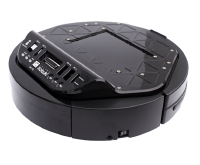Kobuki Robot

A robotic device with a programmable microcontroller, which was used to create a simple self-driving device that responded to obstacles and bends in a road. This was developed with the LabVIEW visual programming language, which is a data-driven language, versus the more traditional Imperative languages. One of the most difficult aspects of the project was shifting my approach on the programming to focus more on the data itself rather than just the program control flow. The next significantly difficult hurdle was simply developing the framework for handling the sensor input, as the sensors included not just cameras, but also depth sensors underneath the Kobuki, and microphones. Eventually, we settled on a state machine that would only transition state based on if the input data passed certain numeric thresholds. For example, the main state may be a trivial ‘Drive Forward’, where the wheels would rotate at the same speed and thus propel the Kobuki forward. There would then be boolean connections to the next state that were driven by the sensor input, such that if the depth sensor on the right side had a 30% delta in voltage, then the machine would transition to the ‘Steer Left’ state. If the depth sensor detected an even more extreme delta, it could transition to the ‘Reverse’ state for a certain time period, and then transition to the ‘Steer Left’ state afterwards. Each state would be passed data on why the state transition happened, so that the next decision could be made more intelligently.
These states were built up more and more over time, until the Kobuki could intelligently navigate an entire complex obstacle course. The biggest trade-offs were between development time, execution time, and reliability. You could very easily iterate on the state machine to theoretically pass a given obstacle course, but it was most easily done through extremely slow and careful driving. If an obstacle was detectected, the machine could turn only 1 degree and attempt to travel again, and it could keep turning 1 degree at a time, until it was navigated. It would be much faster to have the machine turn 25 degrees upon meeting an obstacle, but then you may turn too much and hit another obstacle and thus get stuck in an infinite loop. Having the software-implemented state machine run on hardware was the greatest test of reliability of the code, as it felt like everything that could go wrong would go wrong as soon as the machine was actually running on the track.